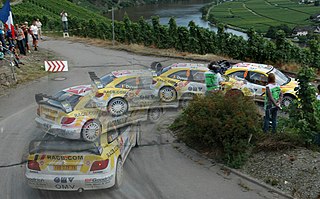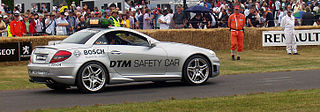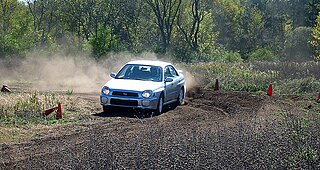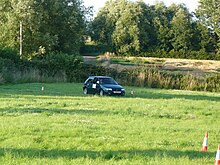
The handbrake turn is a driving technique used to deliberately slide a car sideways, either for the purpose of quickly negotiating a very tight bend, or for turning around well within the vehicle's own turning diameter.
Motorsport(s) or motor sport(s) are sporting events, competitions and related activities that primarily involve the use of automobiles, motorcycles, motorboats and powered aircraft. For each of these vehicle types, the more specific terms automobile sport, motorcycle sport, power boating and air sports may be used commonly, or officially by organisers and governing bodies.

Autocross is a form of motorsport in which competitors are timed to complete a short course using automobiles on a dirt or grass surface, excepting where sealed surfaces are used in United States. Rules vary according to the governing or sanctioning body, such as the length of the course, the amount of permitted attempts, or whether competitors start the course individually at intervals or at the same time as others. In this latter form, Autocross differs from other forms of motor racing by using a system of heats or alternative timing methods for the classification rather than racing for position and declaring the first across the finish line as the winner.
The numerous Formula One regulations, made and enforced by the FIA and later the FISA, have changed dramatically since the first Formula One World Championship in 1950. This article covers the current state of F1 technical and sporting regulations, as well as the history of the technical regulations since 1950.
Motorkhana is a low-cost form of motorsport, unique to Australia and New Zealand but similar to autotesting in the UK and Ireland and gymkhana in the US. It involves manoeuvring a car through tight tests as quickly as possible - one car at a time - on either dirt or bitumen surfaces. This usually requires sliding and spinning the car accurately while maintaining speed through the test course. Some reversing is usually included.

Off-roading is the act of driving or riding in a vehicle on unpaved surfaces such as sand, dirt, gravel, riverbeds, mud, snow, rocks, or other natural terrain. Off-roading ranges from casual drives with regular vehicles to competitive events with customized vehicles and skilled drivers.

The 2000 Austrian Grand Prix was a Formula One motor race held on 16 July 2000, at the A1-Ring near Spielberg, Styria, Austria, attended by 85,112 spectators. The 24th Austrian Grand Prix was the tenth round of the 2000 Formula One World Championship. McLaren's Mika Häkkinen won the 71-lap race from pole position, with teammate David Coulthard second and Ferrari's Rubens Barrichello third.

In motorsport, a safety car, or a pace car, is an automobile which limits the speed of competing cars or motorcycles on a racetrack in the case of a caution period such as an obstruction on the track or bad weather. The aim of the safety car is to enable the clearance of any obstruction under safer conditions, especially for marshals and/or await more favourable track conditions weather-wise. By following the safety car, the competitors' tyres remain as close as possible to operating temperature while their engines do not overheat. A safety car is also preferred over stopping the race and restarting as the latter takes longer.

Racing flags are traditionally used in auto racing and similar motorsports to indicate track conditions and to communicate important messages to drivers. Typically, the starter, sometimes the grand marshal of a race, waves the flags atop a flag stand near the start/finish line. Track marshals are also stationed at observation posts along the race track in order to communicate both local and course-wide conditions to drivers. Alternatively, some race tracks employ lights to supplement the primary flag at the start/finish line.
A bootleg turn is a driving maneuver intended to reverse the direction of travel of a forward-moving automobile by 180 degrees in a minimum amount of time while staying within the width of a two-lane road. This maneuver is also known as a smuggler's turn, powerslide, or simply bootlegger.

Trail braking is a driving and motorcycle riding technique where the brakes are used beyond the entrance to a turn (turn-in), and then gradually released. Depending on a number of factors, the driver fully releases brake pressure at any point between turn-in and the apex of the turn.

RallyCross, also known as RallyX, is a type of car competition in the United States and Canada, sanctioned by Sports Car Club of America (SCCA). It is a timed event that involves solo driving on grass or dirt and can be considered "autocross on the dirt." As with autocross, the emphasis is on driver skill and handling rather than absolute speed, with frequent corners generally keeping speeds below 60 mph (100 km/h). In many ways RallyCross is to rally racing as autocross is to road racing.

The Firestone Firehawk 600 was a planned American open-wheel car race scheduled for April 29, 2001 at the Texas Motor Speedway in Fort Worth, Texas, United States. The event was sanctioned by Championship Auto Racing Teams (CART) and was the third round of the 2001 CART season. It was scheduled for 248 laps around the 1.5-mile (2.4 km) oval track. However, the race was postponed and ultimately canceled due to concerns about driver safety, as the high speeds the cars sustained through the circuit's long corners could potentially have led to drivers experiencing g-force induced loss of consciousness. It was the only race in CART history that was canceled outright for safety reasons. Kenny Bräck was awarded one point for qualifying on pole position at an average speed of 233.344 miles per hour (375.531 km/h).

Gymkhana is a type of motorsport, known as Motorkhana in Australia and New Zealand and as Autotesting in the United Kingdom and Ireland. Similar to autocross, the goal of gymkhana is to achieve the fastest time possible; memorizing the course is a significant part of achieving a fast time. The name is loaned from the equestrian discipline of gymkhana.

Paul Russell "Russ" Swift is a British driver who is known for performing stunts and for precision driving.
The following is a glossary of terminology used in motorsport, along with explanations of their meanings.
Canada's Worst Driver 5 was the fifth season of the Canadian reality TV show Canada's Worst Driver, which aired on the Discovery Channel. As with previous years, eight people, nominated by their family or friends, enter the Driver Rehabilitation Centre to improve their driving skills. This year, the Driver Rehabilitation Centre is located at CFB Borden, the military base previously used as the rehab centre for Canada's Worst Driver 2; however, it is only referred to on-air by Andrew as an "undisclosed military location." The focus of this season was on Driver's Boot Camp. The series launch was set to coincide with the launch of a new law in Ontario prohibiting the use of handheld electronic devices while driving. Similar bans have been instituted in Atlantic Canada and Quebec, with Manitoba and Saskatchewan considering similar laws. The initial drive started in Barrie, Ontario and the final road test occurred in Toronto, Ontario for the second year in a row and third in the last four seasons. This season will also be the second to be featured on the iTunes Store and the first to have new episodes one day after first airing.

In the United States, autocross is an individual motorsport in which drivers compete to set the fastest time on a temporary course. It differs from autocross in the rest of the world as events are usually held on large paved areas, such as parking lots or airfields compared to grass or dirt surfaces used elsewhere. Courses consist of turns, offsets, and slaloms marked by traffic cones; new courses are typically created for each event. In the rest of the world these types of events are known as autotests, autoslaloms or gymkhanas.

The 2017 Chinese Grand Prix was a Formula One motor race that took place on 9 April 2017 at the Shanghai International Circuit in Shanghai, China. The race was the second round of the 2017 FIA Formula One World Championship, and marked the fourteenth time that the Chinese Grand Prix has been run as a round of the Formula One World Championship.

Autoslalom is a form of motorsport that takes place on short, temporary courses marked out on areas of sealed-surfaces such as car parks or disused airport runways. Competitors are timed to complete the course, with penalties given for diverting from the route or for touching the course markers. Each competitor starts individually and speeds are kept low to emphasise safety and to require good vehicle control.
















